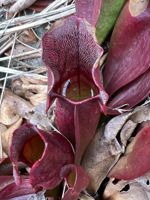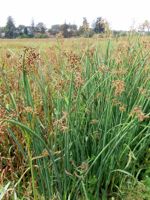Mon-Fri 9am - 5pm Mountain time
Purple Pitcher Plant vs Softstem Bulrush
Sarracenia purpurea
Schoenoplectus tabernaemontani
CUSTOM GROW
CUSTOM GROW
Purple Pitcher Plant is a native carnivorous plant, easily recognized by its purple-tinged, tubular pitchers that capture and digest insects. The nectar along the rim attracts insects to the pitcher, where slippery surfaces and downward-pointing hairs cause them to fall into the fluid below. Once inside, they are broken down, providing nutrients that allow the plant to thrive in nutrient-poor soils.
The plant produces nodding, purple-red flowers held high above the leaves. Interestingly, these blooms are pollinated by the Pitcher Plant Fly (Fletcherimyia fletcheri), whose larvae live in the fluid of the pitchers and feed on some of the trapped insects. It can be found in bogs, fens, and other wetlands. It is well-suited for wetland gardens, restoration, and naturalisation projects.
The Purple Pitcher Plant can be challenging to grow because of its specific requirements. It thrives in consistently moist (but not waterlogged), acidic soil, with a peat-and-sand mix typically recommended. The plant is sensitive to fertilizers, dissolved salts, and chlorinated water. When given the right conditions, full sun will bring out its brightest colors.
The Purple Pitcher Plant is the provincial flower of Newfoundland & Labrador.
Softstem Bulrush is a native perennial sedge that forms dense colonies of tall, upright stems. Thriving in saturated soils and shallow water, it spreads vigorously by rhizomes, creating large colonies that stabilize shorelines, control erosion, and strengthen wetland ecosystems.
Dense stands of Softstem Bulrush create shelter and nesting sites for birds, while also supporting aquatic invertebrates and the larvae of numerous insects. It is also an important food source. Many wetland birds, especially ducks, feed on the seeds, while muskrats feed on the foliage and rhizomes. Well-suited for ecological restoration, waterside & riparian plantings, erosion control, and habitat enhancement projects.

